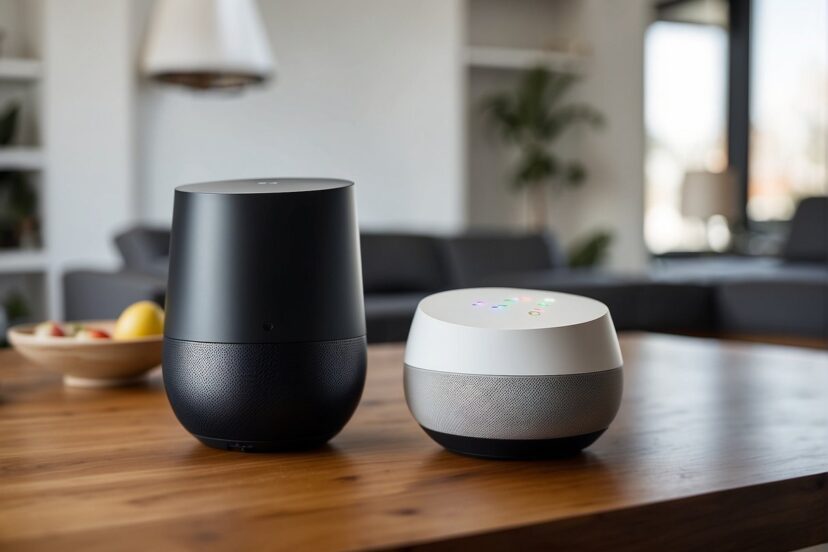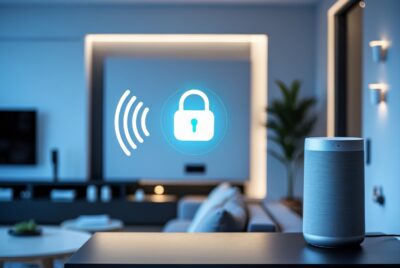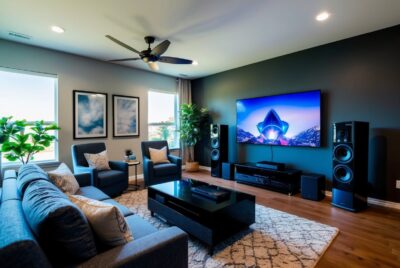Google Home Security Tips: Securing Your Smart Home Ecosystem
*We may earn a commission for purchases made using our links. Please see our disclosure to learn more.
Google Home Security Tips: Securing Your Smart Home Ecosystem
In the realm of smart home technology, Google Home Security is emerging as a comprehensive solution for those looking to integrate advanced security features into their daily lives. As an extension of the Google Home ecosystem, this security system harmonizes with various compatible devices such as smart locks, cameras, and sensors to enhance the safety of one’s living space. The emphasis on compatibility with Matter, an industry-unifying standard, ensures that these devices can interact seamlessly, providing users with a streamlined experience right from the setup.
I appreciate the importance of customizing security to fit individual needs, which is why the flexibility of Google Home Security appeals to me. Users can choose from a wide range of devices like smart doorbells with cameras that offer high-definition video surveillance, as well as the ability to control and monitor their home remotely. Both indoor and outdoor smart security cameras from the Google Nest line are designed to be user-friendly, featuring 1080p HDR video quality that doesn’t miss a detail.
The intelligent alert system, an integral part of Google Home Security, is particularly noteworthy. It notifies users of specific events such as package deliveries or unexpected visitors, ensuring one is always informed about the goings-on in and around their property. Investing in Google Home Security provides not just a sense of safety, but also a convenient way to manage home security through integrated technology that learns and adapts to one’s lifestyle and preferences.
Overview of Google Home Security

In today’s interconnected world, Google Home Security has positioned itself as a seamless solution for home protection. My focus here is to unveil its key features and system components that cater to modern security needs.
Key Features
- Integration with Google Assistant: I can control the security system with my voice, making it convenient to arm or check the status without manual inputs.
- Smart Device Compatibility: The platform works in harmony with an array of smart devices such as doorbells, sensors, and cameras, thus allowing me to customize my home security setup.
- Privacy Controls: Google has implemented strict privacy controls, ensuring that my data remains secure and private, with options to manage data sharing and access.
- Mobile App Management: I have the ability to monitor and control the security system remotely through the Google Home app.
System Components
- Nest Hub Max: A central command center that also functions as a smart speaker and display.
- Nest Doorbell: A battery-powered video doorbell that sends me alerts and allows me to communicate with visitors.
- Nest Cam: This battery-powered security camera can be placed indoors or outdoors to monitor different areas of my home.
- Nest Mini: An optional addition that extends the reach of voice commands and interactions with the Google Home Security system.
Installation and Setup

Setting up a Google Home Security system involves careful preparation and a structured step-by-step process. I’ll guide you through both the preparation and the actual installation, ensuring your system is up and running effectively.
Preparation and Requirements
To begin, ensure you have the necessary components for your Nest Secure alarm system, which include the Nest Guard (the central hub), Nest Detect sensors, and optional Nest Connect to extend the range. I recommend using the Nest app as your primary guide, which provides interactive installation instructions. As for the Nest Protect smoke and carbon monoxide detector, it’s crucial that you identify the best locations around your home for installation, typically on ceilings or high on walls.
- Wi-Fi: A stable home Wi-Fi network is essential.
- Smartphone or Tablet: Needed for the Nest app.
- Power Sources: Access to power outlets for the Nest Guard.
- Tools: You might need basic tools for mounting detectors.
Step-By-Step Installation Process
For your Nest Guard, select a central location within your home, so it can communicate effectively with all Detect sensors. Plug in your Guard to power it up, and follow the Nest app’s instructions to connect it to Wi-Fi and add it to your home in the app.
Installing Nest Detect sensors consists of a few clear steps:
- Choose doors, windows, or rooms for placement.
- Use the enclosed adhesive strips or screws to secure the Detects.
- Set up each Detect in the Nest app, which includes scanning the QR code on the device.
For Nest Protect, the process is similarly straightforward:
- Screw in the backplate to the desired location.
- Attach your Nest Protect to the backplate.
- Connect it to the Nest app and your Wi-Fi network.
Keep in mind that for a proper setup, always refer back to the specific instructions given in the Nest app, as it will provide troubleshooting steps and tips to ensure the installation is successful.
Integration with Smart Home Devices
In my knowledge, integrating security systems with Google Home not only enhances home protection but also simplifies managing various smart devices through a unified platform.
Compatibility with Other Devices
Google Home’s capability to work with smart devices improves with the support of Matter, which is a unifying standard for smart home technology, enabling devices from different manufacturers to interact seamlessly. My understanding is that the wide range of compatible devices includes:
- Sensors: Detect movements, openings, or environmental changes
- Locks: Secure access with smart locks controllable via voice
- Motion Detectors: Trigger alarms or notifications upon detecting activity
- Thermostats: Adjust climate settings through voice commands
- Lights: Turn on/off or dim lights using voice commands or schedules
- Outlets: Control power to appliances remotely or through voice
- Garage Doors: Open or close garage doors with voice commands
These integrations enable a comprehensive smart home setup controlled effectively through Google Home.
Managing Devices Through Google Home App
My experience with the Google Home app tells me it offers a streamlined way to link and control all compatible devices. Users can:
- Customize Device Settings: Adjust preferences for each device to match your desired smart home behavior
- Create Routines: Automate device actions based on time, location, or other triggers
- Voice Activation: Use voice commands to control devices without manual interaction
The app serves as a centralized hub, offering convenience and more control over your smart environment.
Security and Privacy of Google Home Security
In addressing security and privacy for Google Home devices, I’m focusing on established data protection measures and available user privacy controls to ensure users can manage their own information safely.
Data Protection Measures
Google Home security systems have inherent features intended to safeguard user data. Encryption is utilized to secure data in transit and at rest. Moreover, security updates are routinely pushed to devices to defend against emerging threats.
- Encryption: All communications between Google Home devices and Google servers are encrypted.
- Regular Updates: Devices receive automatic updates to maintain robust security.
User Privacy Controls
I maintain control over my personal information through various privacy settings in my Google Home devices. These settings enable me to manage how my data is collected and used.
- Voice Match: This feature ensures that my Google Home responds to my specific voice, reducing the likelihood of unauthorized access.
- Mute Functionality: I can deactivate the device’s microphone to prevent any inadvertent data collection.
By adjusting these settings, I exercise direct control over my privacy when using Google Home.
Troubleshooting and Support
In my experience with Google Home security products, users can often resolve common issues with straightforward fixes. Additionally, Google provides a variety of support resources to assist customers in need.
Common Issues and Solutions
Issue: Device not responding
Solution: Often, a simple reboot can fix this issue. Through the Google Home app, go to Devices, select the non-responsive device, and tap on the three dots to find the reboot option.
Issue: Setup challenges
Solution: Ensure the device is placed according to the manufacturer’s guidance. For Nest Secure, this includes one Guard and two Detect sensors, placed appropriately for optimal detection.
Customer Support Resources
Google Nest Help Center
I recommend starting with the Google Nest Help Center, which offers guidance tailored to your region—U.S., U.K., Canada, Australia, etc. The Help Center contains detailed articles, setup guides, and troubleshooting steps.
Contact Options
If you need further assistance, contact Google’s customer support directly through the Help Center. Specific contact options and hours will be provided based on your location and the nature of your inquiry.
Frequently Asked Questions
1. What types of security cameras are compatible with Google Home?
My research indicates that Google Home supports a wide variety of smart security cameras. Specifically, devices that have compatibility with Google Assistant can be used seamlessly with Google Home, such as the Nest Cam which offers a 130-degree field of view.
2. How does the Google Home app integrate with home security features?
The Google Home app serves as a central hub where you can access and control various security devices. Within the app, you can configure settings like voice recognition and connect to compatible cameras, sensors, and smart locks for an integrated home security system.
3. What are the components included in the Google Nest Security Bundle?
The Google Nest Security Bundle traditionally includes the Nest Guard, which is the central unit, and Nest Detect sensors. These components work together to monitor your home and alert you to any security issues.
4. How do Google Nest and Google Home differ in terms of security offerings?
Google Nest focuses more on security products, including smart cameras and alarm systems. Google Home, meanwhile, is a suite of smart home devices and serves as a platform that can manage and control a mixed ecosystem of compatible smart devices, including those for security.
5. What alternatives are available following the discontinuation of certain Google Nest products?
Since some Google Nest products have been discontinued, alternatives include other Google-compatible security products from different manufacturers. You can choose from thousands of devices to craft a security system that fits your specific needs.




